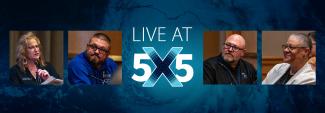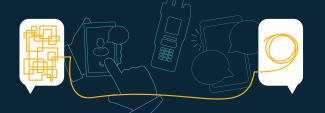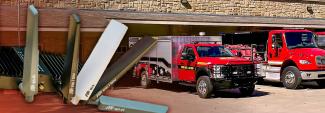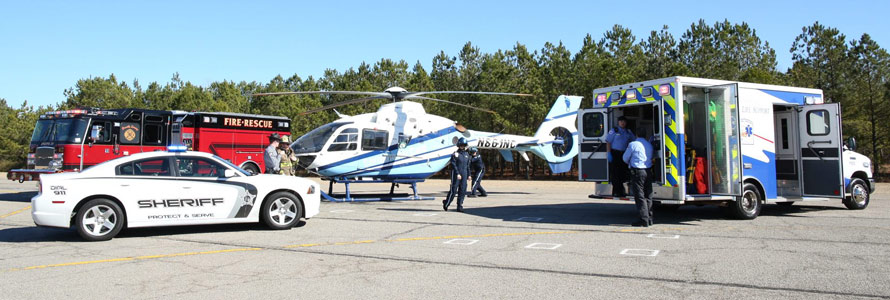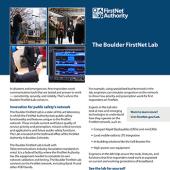Summary
San Bernardino County’s Assistant Fire Chief Dan Munsey reflects on emerging technologies, such as drones and wearables, and how they will transform fire service operations in the years to come.
Guest
Michael Varney
FirstNet Authority Director of the Northeast Region
Assistant Fire Chief Dan Munsey
San Bernardino County (CA) Fire Protection District
Transcript
Preview
Narrator: You're listening to Public Safety First – a podcast to help you learn about the First Responder Network Authority and how you can be part of the future of public safety technology. And now, your host.
Michael Varney: Morning, it’s Michael Varney from the First Responder Network Authority, here with Dan Munsey, who will introduce himself in a second, at Fire-Rescue International in Dallas, Texas. And we’re going to talk about the future of FirstNet and how it will be used in the fire service. So Dan, why don’t you tell me a little bit about yourself?
Narrator: You're listening to Public Safety First – a podcast to help you learn about the First Responder Network Authority and how you can be part of the future of public safety technology. And now, your host.
Michael Varney: Morning, it’s Michael Varney from the First Responder Network Authority, here with Dan Munsey, who will introduce himself in a second, at Fire-Rescue International in Dallas, Texas. And we’re going to talk about the future of FirstNet and how it will be used in the fire service. So Dan, why don’t you tell me a little bit about yourself?
Dan Munsey: Sure, I’m an assistant chief with the county of San Bernardino Fire Protection District in Division 2, which is sort of San Bernardino, kind of the east San Bernardino Valley, including the cities of San Bernardino and up—San Bernardino, Grand Terrace, Muscoy, Mentone, and Devore. I also sit on the Cal Chiefs’ [California Fire Chiefs Association] Ops Section Board as the chairperson there, and I’m on the IAFC [International Association of Fire Chiefs] Tech council this year.
Michael Varney: Great. So, how did you get involved with technology and communications in the fire service?
Dan Munsey: Literally, I missed a meeting last year at the Cal Chiefs conference for the operations section and when I showed up, everybody said, “Congratulations, you’re our new chairperson.” And I told the group, “Hey, we’re not just going to be meeting just to meet. We have enough of those things in our life. If we’re going to do something, let’s do something that will make an impact.” So, we did a needs study and the number one need in the fire service right now is education on technology. So, the Cal Chief Op group set a technology forum in partnership with Esri and invited some of the best leaders in technology and the industry in for a two-day summit and started educating our members. And from there, I really launched into learning a lot about, more about technology, and trying to get ahead of this technology curve to answer a couple simple questions. One is—what technology should the fire service be adopting? Two is—the technology that we’re adopting, is it going to have interoperability with our neighbors? And three is—is the technology that we’re adopting going to be supported in the future? So, it’s been an incredible road over the last two years. I’ve also been very blessed to work with a very progressive fire department that’s implementing quite a bit of technology, especially over the last five years in the operations and human resources world.
Michael Varney: So Dan, based on what you’ve learned over the last year with that summit that you put together, what would you say are the highest priorities that should be addressed by FirstNet to help you solve some of these issues that you came across?
Dan Munsey: I think what you’re doing is good. Every conference, every meeting that I’ve gone to for the last two years, you have a presence. I think that pretty much everybody in the nation has seen your PowerPoint, your presentation, introducing what you’re doing and how you’re going to do it. I’m really happy with the way you’re engaging and soliciting feedback from the fire service and you’re asking us what are our needs? I think there really isn’t a collective opinion right now on what those needs are. I think that that needs to come from some of the organizations like the IAFC that provides that direction for the fire service. All of us, well, we were raised as firefighters kicking down doors and putting fires out, but none of us were raised with the technologies available. We just simply do not know what we do not know. And FirstNet needs to do some education about what is possible and ‘this is the world we see you living in’ and then provide some timeframes for when that’s going to happen. So, over the last few years, wearable technology is becoming forefront in the fire service, and that’s going to allow us to have a safer fire service and keep our firefighters safe. Some of that wearable technology that we’ve seen at the Tech Council over the last couple of days has been amazing. One of the devices that sticks in my head was just a simple flashover monitor, and the monitor is about the size of a pass device, fits on the SCBA belt and it monitors ambient air temperature. When a certain temperature is reached, 300 degrees, you get the first alarm. When the second alarm goes off, it’s 600 degrees, that’s indicating that flashover is going to occur within 20 to 30 seconds, and then more importantly, that information is relayed back to the command post, to some sort of mobile device that’s tracking every firefighter on the fire ground. So, wearable technology’s coming in. We’re also looking at UAVs and drones. There’s going to be a lot more use of drones in the future for fire service, and that’s driven by efficiency. Right now, in some of our areas, we may respond to a reported car crash and when we get there, we may find that that car crash is more than we thought—it’s a school bus on its side, or it’s a car that’s flipped over into a river. Being able to deploy drones on dispatch to get out and give us a situational awareness to be able to modify alarms, are things that we’re going to see in the future. Smart buildings is something else that’s going to be integral to public safety and firefighters’ safeties. But buildings that talk to us and provide us the information – where are our victims located, how many victims are still in the building, how many have exited the building, a better situational awareness of the heat and the venting systems of the building, and everything—what I’ve learned over the last three years is that pretty much everything that we interface with, with humans, has some sort of connectivity. We’ve created a virtual world that lives right alongside our world but we’re not using that virtual world anywhere near its capacity in public safety.
Michael Varney: Yeah, excellent. Lots of things to get your head around to try to plan for in the future to make our jobs safer and better.
Dan Munsey: Well see, and that’s the deal, Mike. I try to stay educated on this. I think I’m doing better than most chief officers, but there’s many chief officers that don’t have the time to invest into looking at all the technology and reviewing all the products, and learning about data collection. They’re looking for very simply interfaces and they’re looking for someone to come to them and say, “Look this is what’s possible. We’re going to be able to provide this to you for a really reasonable cost, and you can learn to do this in thirty seconds.”
Michael Varney: Good point. As we know, as we said in the main conference yesterday, that apps and data certainly are as important as halligans and axes nowadays. So, how do you think that FirstNet can help you navigate that landscape as you see it happening in the future?
Dan Munsey: Well, all the connectivity exists already. There are buildings that the cities are using to talk to the building and code. But we don’t have access to that data as a fire service and I think FirstNet needs to do two things. One is provide that reliable data transmission at the quickest speeds possible, and the second is, it has to open some doors and create a collective of data collaboration. So, not only when my units are responding in my jurisdiction, but when they head to a fire in another jurisdiction, I need to have access to that information as well. There should not be any jurisdictional boundaries, and I hope FirstNet really leads the way in connecting the entire nation and the fire service.
Michael Varney: Dan, could you tell me about that summit you put together earlier this year in California? I know it was quite a success and it was the first one done, so could you just share with everybody what you were able to accomplish?
Dan Munsey: Sure, so the California Fire Chiefs Association Operations Section partnered with Esri, kind of a unique partnership, and we went to Esri and we literally said, “We need to get a better grasp on technology. We need to understand what the Esri products are, which 90 percent of our fire departments own—we don’t even know that we own it, and are available to us. And we have to have a better grasp on who are the emerging leaders for fire service technology.” So, we created a two-day event and had 15 of the industry leaders come in, anywhere from Deccan International to BCS to INTERA, which is another great company, Tablet Command, some of the true leaders, the IAFC Tech Council was there, TEEX [Texas A&M Engineering Extension Service] was there, to educate our fire chief members about the available technology and to discuss where technology was going into the future. So this tech summit was very successful, and it seems to be pretty well-known across the nation and now the IAFC is looking to partner with different organizations. Just yesterday, I had a conversation with the Texas Fire Chiefs Association about how we did it and volunteered to help them set up a similar product for their chief officers, but I think our major goal needs to be to educate the fire service on what technology is available, and how we can adopt that technology.
Michael Varney: Great. So Dan, how did you get involved in the fire service?
Dan Munsey: You know, I literally fell into it. I was a rock climber and my friend fell and broke his back, and I didn’t know what to do, so I took an EMT [emergency medical technician] class and did it right out of the fire department, and it took me about 30 minutes for me to realize that that’s the career I wanted to do. I’ve been doing it now since 1995 and every day I get up, shave, and I put my uniform on, and I look in the mirror and say, “Thank god I don’t have to go to work today.” And then I get in my car and I show up at the fire station. I have a job that I look forward to, and why? You’re making a difference every single day. You can walk away and say, “Look, I did this.” There’s probably not a more exciting career in which you truly get to help people solve problems. Problem solving—let me just stop real quick there—I said I put on the uniform, and on my uniform, on my badge, it says “fire chief,” and on my shoulder patch, it says “fire department.” But truthfully what we are, are problem solvers in society and we really need to have that mindset that we may not be facing fire today, but we are going to face a problem, and how can we provide the best customer service and community service to solve that.
Michael Varney: That’s a great point, Dan. I appreciate that. I appreciate all your time today.
Dan Munsey: Thanks, it’s always an honor.
Narrator: Thanks for listening today. We're excited to have you join our podcast community. Make sure to subscribe on iTunes, SoundCloud, and YouTube. You can learn more about the First Responder Network Authority at FirstNet.gov and learn about FirstNet products and services at FirsNet.com.



